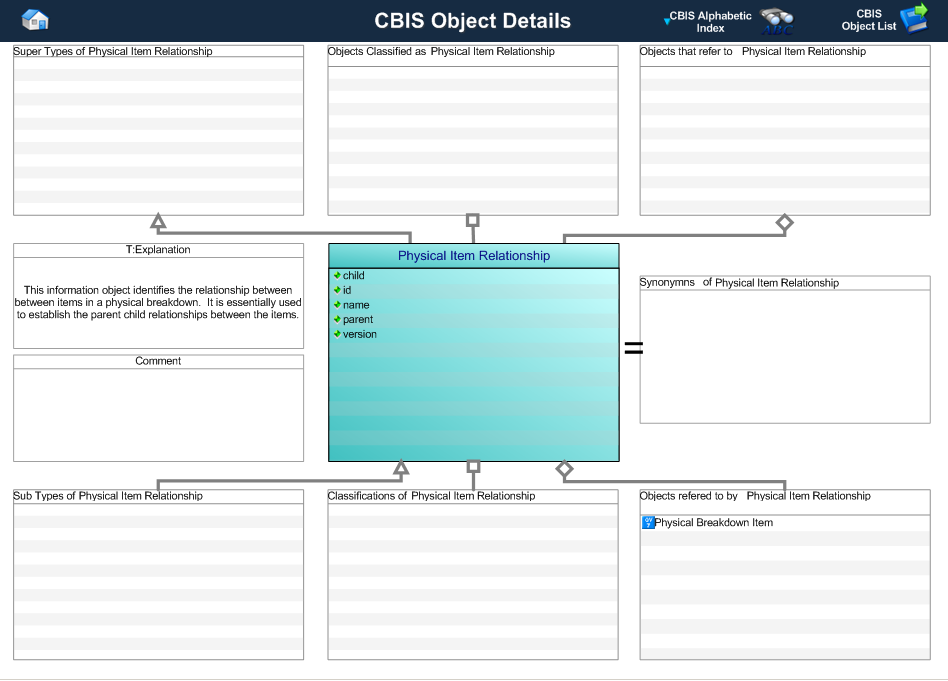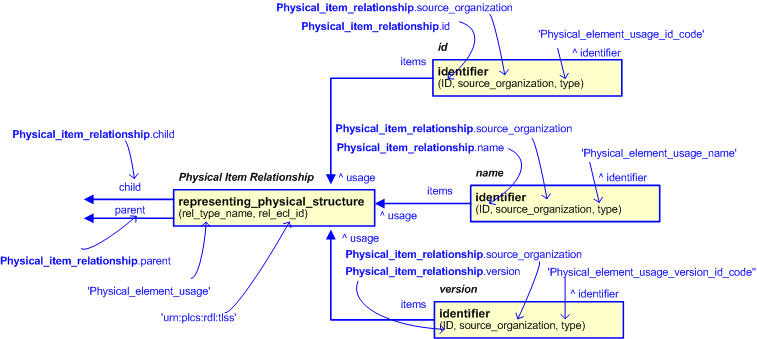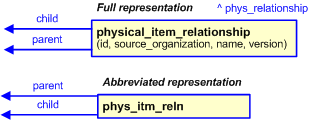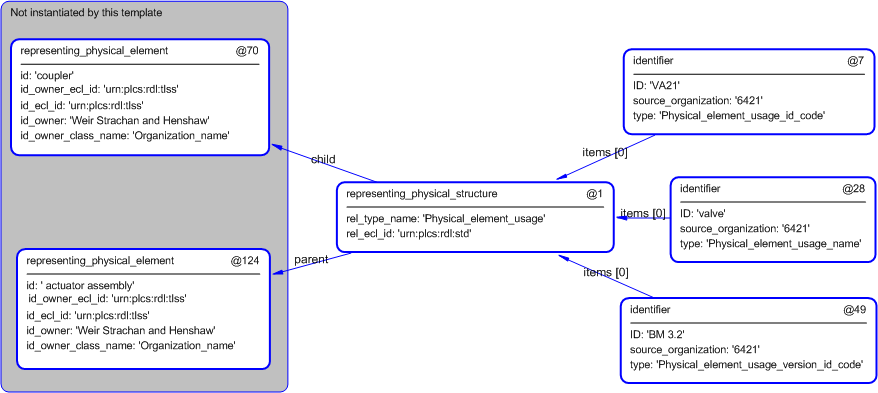Template:— physical_item_relationship (phys_itm_reln)
Context:— UK_Defence |
Date: 2009/04/17 10:48:48
Revision: 1.2
|
This section specifies the template physical_item_relationship.
NOTE
The template has been defined in the context of
UK_Defence.
Refer to the business context for details of related templates.
NOTE
An explanation of a template and the associated instantiation path is
provided in the
Template overview
section.
This template describes how to represent the UK_Defence concept of a physical item relationship
in terms of PLCS model elements (templates, entities, and reference data).
This information object identifies the relationship between between items in a physical breakdown. It is essentially
used to establish the parent child relationships between the items.
This information object identifies the relationship between between items in a physical breakdown. It is essentially
used to establish the parent child relationships between the items.
Figure 1 — Graphical Representation for Business Object Physical Item Relationship
|
Attribute name
|
Attribute description
|
Attribute type
|
Optionality
|
| child |
This attribute identifies the child node in a hierarchical relationship. |
Physical Breakdown Item |
Mandatory |
| id |
This attribute provides the identifier of the physical item relationship. |
Identifier |
Mandatory |
| Identifier.id |
This is the value of the id attribute of the Identifier applied to the physical item relationship. |
intrinsic |
Mandatory |
| Identifier.type |
This attribute is the type associated with the id of the Identifier given to the physical item relationship. |
Physical_element_usage_id_code |
Mandatory |
| Identifier.source_organization |
This attribute is the value representing the source organization that provides the id of the Identifier given to the physical
item relationship. This value is assumed to be a type of Organization_identification_code.
|
Organization_identification_code |
Mandatory |
| name |
This attribute provides the name of the physical item relationship. |
Intrinsic |
Mandatory |
| parent |
This attribute specifies the parent or upper node in a hierarchical relationship. |
Physical Breakdown Item |
Mandatory |
| version |
This attribute provides the version of the physical item relationship. |
Intrinsic |
Mandatory |
Table 1 — Physical Item Relationship attribute details
The EXPRESS-G diagram in
Figure
2
shows the templates and EXPRESS entities that are required
to represent the template
"physical_item_relationship".
The text highlighted in blue shows the template parameters.
Figure 2 — An EXPRESS-G representation of the Information model for physical_item_relationship
The graphic for the template to be used in other EXPRESS-G diagrams
is shown in Figure
3
below.
Figure 3 — The graphical representation of the physical_item_relationship template
The following input parameters are defined for this template:
The identifier of the physical item relationship.
The organization or information system that created the associated identifier. Alternatively this could be set to /NULL when
Person or Information System is the source; see Identifier template characterizations.
The name of the physical item relationship.
The version identifier of the physical item relationship.
The parent physical element definition.
The child physical element definition.
The following reference parameters are defined for this template:
Allow the
Physical_element_usage
entity instantiated in this path to be referenced when this template is used.
%^target = $physical_item_relationship.phys_relationship%
The instantiation path shown below specifies the entities that are to be
instantiated by the template.
A description of templates and the syntax for the instantiation path is
provided in the
Templates Help/Information section.
/
representing_physical_structure(
rel_type_name='Physical_element_usage',
rel_ecl_id='urn:plcs:rdl:uk_defence',
parent=@parent,
child=@child)/
-- assign ref parameters %^phys_relationship = $representing_physical_structure.usage%
-- id /
identifier(
ID=@id,
source_organization=@source_organization,
type='Physical_element_usage_id_code',
items=^phys_relationship)/
-- name /
identifier(
ID=@name,
source_organization=@source_organization,
type='Physical_element_usage_name',
items=^phys_relationship)/
-- version /
identifier(
ID=@version,
source_organization=@source_organization,
type='Physical_element_usage_version_id_code',
items=^phys_relationship)/
The instance diagram in Figure
4
shows an example of the EXPRESS entities and templates that are instantiated by the template:
/physical_item_relationship(id='VA21', source_organization='6421', name='valve', version='BM 3.2', parent='@124', child='@70')/
(an illustration of the consolidated physical_item_relationship template is shown in
Figure
5 below.)
Figure 4 — Entities instantiated by physical_item_relationship template
The instance diagram in
Figure
5
shows the graphic symbol for the template that is to be
used in other instance diagrams. The example template is:
/physical_item_relationship(id='VA21', source_organization='6421', name='valve', version='BM 3.2', parent='@124', child='@70')/
Figure 5 — Instantiation of physical_item_relationship template
Characterizations
No common characterizations of the template
physical_item_relationship
have been identified. However, the ISO 10303-239 EXPRESS model
may enable other assignments to the entities instantiated by the template.




